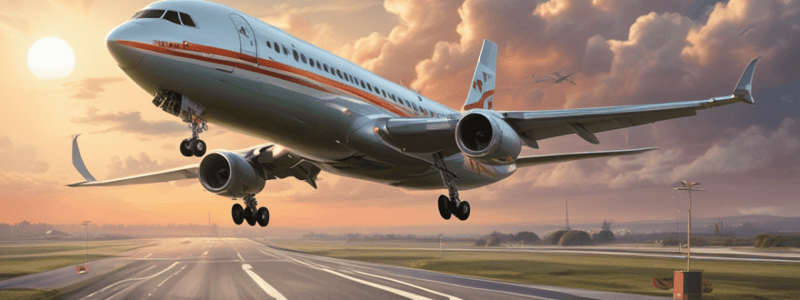Podcast
Questions and Answers
What should a pilot do when the fuel gauges are broken?
What should a pilot do when the fuel gauges are broken?
- Can take-off, have MEL & company Operation manual (correct)
- Abort the take-off immediately
- Use visual inspection to estimate fuel amount
- Wait for maintenance to fix it
What is the correct code and mode for an aircraft in high control airspace?
What is the correct code and mode for an aircraft in high control airspace?
- 7700 and Mode A
- 2000 and Mode C (correct)
- 7500 and Mode S
- 1200 and Mode A
Which frequency should be used first when at an uncontrolled airport with no ground station?
Which frequency should be used first when at an uncontrolled airport with no ground station?
- 124.0
- 123.45
- 121.5
- 126.7 (correct)
How should ASDA (Accelerate-Stop Distance Available) be defined?
How should ASDA (Accelerate-Stop Distance Available) be defined?
Define compression sickness
Define compression sickness
How many crew need to where a seat belt?
How many crew need to where a seat belt?
Which is best with FL310-FL350
Which is best with FL310-FL350
How do turbo jet aircraft use reverse
How do turbo jet aircraft use reverse
A/C at uncontrolled airport, no ground station, so…
A/C at uncontrolled airport, no ground station, so…
How is TODA defined?
How is TODA defined?
When should you file flight plan at Arctic area above
When should you file flight plan at Arctic area above
How far do you avoid a forecast fire area
How far do you avoid a forecast fire area
ADIZ report
ADIZ report
When to set 29.92 from altimeter setting region to standard
When to set 29.92 from altimeter setting region to standard
Flashcards are hidden until you start studying
Study Notes
Safety Regulations
- At least one pilot should wear a safety belt during flight.
Engine Operations
- Turbo-Jet Aircraft have reverse thrust, which uses exhaust gas to forward the engine.
Fuel Management
- If fuel gauges are broken, take-off is still possible with a Minimum Equipment List (MEL) and company Operation Manual.
Health Risks
- Compression sickness occurs when nitrogen gas forms in tissues.
Air Traffic Control
- In high control airspace with a CODE, the aircraft should be at 2000 feet and have Mode C.
- When at an uncontrolled airport with no ground station, contact 126.7 first, then ATF/MF.
Runway Operations
- ASDA (Accelerate-Stop Distance Available) is equal to TORA (Takeoff Run Available) + STOPWAY.
- TODA (Takeoff Distance Available) is equal to TORA + CLEARWAY.
Flight Planning
- In Arctic Areas, it's necessary to file a flight plan when flying above FL270, which is controlled airspace.
Emergency Procedures
- Forecast fires are reported when the fire is above 3000 feet and within 5NM.
- ADIZ (Air Defense Identification Zone) requirements include contacting authorities within 5 minutes when flying within 20NM.
Altimeter Settings
- When transitioning from an altimeter setting region to standard, set 29.92 from altimeter setting region to standard.
Studying That Suits You
Use AI to generate personalized quizzes and flashcards to suit your learning preferences.




